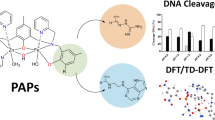Summary
A variety ofmer-[Co(dien)(AA)X]+ (AA = amino acidate, dien = 1,5-diamino-3-azapentane) andmer-[Co(dien)(dipeptideOR)X]2+ complexes (X = Cl or NO2) have been prepared and characterised. Base hydrolysis of the peptide bond in the carbonyl bonded glycyl peptides has been studied at 25°C and I = 0.1 mol dm−3. The rate constants kOH for peptide bond hydrolysis fall within the 0.67–0.88 mol dm−3s−1 range. Base hydrolysis of the complexed peptide isca. 2×104 times faster than for the uncomplexed peptide ligand at 25 °C. The base hydrolysis of the chloro- and nitro-ligands in these complexes has also been studied. Very rapid hydrolysis occurs if the dien ligand adopts amer-configuration and the reactions are 102–104 times faster than for analogous complexes where the dien ligand adopts afac-configuration. These results are in agreement with Tobe's criteria for rapid base hydrolysis in cobalt(III) complexes.
Similar content being viewed by others
Abbreviations
- dien:
-
1,5-diamino-3-azapentane
- dpt:
-
1,7-diamino-4-azaheptane
- glyO:
-
glycinate
- glyOH:
-
glycine
- glyOR:
-
glycine ester
- glyNH2 :
-
glycine amide
- glyglyO:
-
glycylglycinate
- glyglyOR:
-
glycylglycine ester
- glyglyglyOH:
-
triglycine
- α-alaO:
-
α-alaninate
References
R. W. Hay,Bio-Inorganic Chemistry, Ellis Horwood, Chichester, 1984.
W. N. Lipscombe,Chem. Soc. Rev., 1, 319 (1972).
W. N. Lipscombe,Tetrahedron, 30, 1725 (1974).
R. W. Hay and P. J. Morris in H. Sigel (Ed.),Metal Ions in Biological Systems, Vol. 5, Marcel Dekker, New York, N.Y., 1976.
D. A. Buckingham in A. W. Addison, W. R. Cullen, D. Dolphin and B. R. James (Eds.),Biological Aspects of Inorganic Chemistry, Wiley-Interscience, New York, N.Y. 1977.
N. E. Dixon and A. M. Sargeson inZinc Enzymes, T. G. Spiro (Ed.), Wiley, New York, N.Y., 1983.
Y. Wu and D. H. Busch,J. Am. Chem. Soc., 94, 4115 (1972).
K. Ohkawa, J. Fujita and Y. Shimura,Bull. Chem. Soc. Jpn., 45, 161 (1972).
A. Y. Girgis and J. I. Legg,J. Am. Chem. Soc., 94, 8420 (1972).
L. F. Vilas-Boas,PhD thesis, University of Kent at Canterbury, U.K., 1974.
Gillard and Philipps have reported that attempted preparations of [Co(dien)(glyglyglyO)]+ gave [Co(dien)(glyglyO)+, the latter being formed by hydrolysis of the tripeptide. R. D. Gillard and D. A. Phipps,Chem. Comm., 800 (1972).
R. A. Henderson and M. L. Tobe,Inorg. Chem., 16, 2576 (1977).
R. W. Hay and D. P. Piplani,Kemiai Közlémenyek, 48, 47 (1977).
S. H. Caldwell and D. A. House,J. Inorg. Nucl. Chem., 31, 811 (1969).
M. D. Alexander and D. H. Busch,Inorg. Chem., 5, 1590 (1966).
R. A. Robinson and R. H. Stokes,Electrolyte Solutions, 2nd edit., Butterworths, London, 1965.
C. W. Davies,J. Chem. Soc., 2093 (1938).
S. Yamaguchi and S. Ooi, quoted in ref. 8.
R. W. Hay and K. B. Nolan,J. Inorg. Nucl. Chem., 38, 2118 (1976).
L. S. Doug and D. A. House,Inorg. Chem. 4 1522 (1965).
J. P. Collman and E. Kimura,J. Am. Chem. Soc., 89, 6096 (1967).
D. A. Buckingham, C. E. Davis, D. M. Foster and A. M. Sargeson,J. Am. Chem. Soc., 92, 5571 (1970).
R. W. Hay and P. J. Morris,Chem. Comm., 1208 (1969).
D. A. Buckingham, J. MacB. Harrowfield and A. M. Sargeson,J. Am. Chem. Soc., 96, 1726 (1974).
R. W. Hay and R. Bembi,Inorg. Chim. Acta, 64, L199 (1982).
A. Albert and E. P. Sargent,Ionisation Constants of Acids and Bases, Methuen and Co. Ltd., London, 1962.
I. J. Grant and R. W. Hay,Aus. J. Chem., 19, 1189 (1965).
M. M. Jones, T. J. Cook and S. Brammer,J. Inorg. Nucl. Chem., 28, 1265 (1966).
D. A. Buckingham, G. S. Binney, C. R. Clark, B. Garnham and J. Simpson,Inorg. Chem., 24, 135 (1985).
Author information
Authors and Affiliations
Rights and permissions
About this article
Cite this article
Hay, R.W., Reid, V.M.C. & Piplani, D.P. The base hydrolysis ofmer-[Co(1,5-diamino-3-azapentane)(amino acidate)X]+ (X = Cl or NO2) complexes and base hydrolysis of complexed peptides in the coordination sphere of the [Co(dien)]3+ moiety. Transition Met Chem 11, 302–307 (1986). https://doi.org/10.1007/BF00620652
Received:
Issue Date:
DOI: https://doi.org/10.1007/BF00620652




